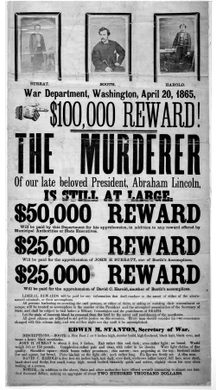Assassin's End
The Virginia farm where John Wilkes Booth met his grisly end is now largely forgotten.
On the evening of April 14th, 1865, famed actor and Confederate sympathizer John Wilkes Booth assassinated President Abraham Lincoln as he watched a play at Ford’s Theater in Washington, D.C. After fleeing pursuit by the Union Army for 12 days, Booth and fellow conspirator David Herold were tracked to a tobacco barn on a rural Virginia farm and cornered. Following a brief standoff, the farm became the site of Booth’s death.
Much of Booth’s escape route from Washington following the assassination was pre-planned. Supplies for his flight were left in advance at a tavern in Surratsville, Maryland, and under the guise of being interested in purchasing land in the area, Booth scouted possible routes through the Zekiah Swamps several times in the months prior to the assassination.
What Booth didn’t plan on, however, was breaking his leg after leaping from Lincoln’s balcony onto the stage at the theater. In considerable pain, Booth and Herold were forced to detour to Dr. Samuel Mudd’s house where his leg was set and a pair of crutches were procured. Even with his leg set, however, Booth and Herold’s escape was slowed and they were largely reliant on the charity of fellow Confederate sympathizers.
The manhunt for John Wilkes Booth was the largest in U.S. history, to that time. Secretary of War Edwin Stanton directed the investigation, dispatching over 10,000 Union troops to conduct the search and placing a $50,000 bounty on Booth’s head (worth approximately $700,000 in 2017).
The fugitives slowly made their way through southern Maryland and into Virginia and eventually arrived at the farm of Richard Garrett, a tobacco farmer near the town of Port Royal, on April 24th. Booth told Garrett that he was a wounded Confederate soldier by the name of “James W. Boyd” and that he and Herold were heading home after the Battle of Petersburg. Garrett later claimed that he was suspicious of Booth’s story but also unaware that Lincoln had been killed and that there was a manhunt for two assassins, so he provided the two men lodging in his tobacco barn.
Booth and Herold were still at the Garrett’s farm two days later when the 16th New York Cavalry arrived, searching for the assassins. After some questioning Garrett directed the soldiers towards the barn. When Union troops threatened to burn the barn down, Herold surrendered but Booth refused to give himself up. Carrying through on their threat, the soldiers then set fire to the barn.
Moments later, claiming he had seen Booth raise a weapon, Sergeant Boston Corbett fired a shot at Booth through a crack in the side of the barn, partially severing Booth’s spinal cord and paralyzing him below the neck. Soldiers then moved Booth to the porch of Garrett’s house where he died two hours later.
In the subsequent decades, thousands came to see the bloody stain at the entrance to the Garrett house where Booth died. After the war, Richard Garrett petitioned the federal government for $2,525 to replace the burned-down barn and the farming equipment that was inside. He was unsuccessful in this, however, as a congressional committee doubted his story that he didn’t know that Lincoln had been assassinated and that there was a manhunt for the fugitives. In the bitter aftermath of the Civil War, the Garrett family were social outcasts. Southerners thought they should have done more to shelter Booth and Northerners didn’t believe that he was unaware who his fateful guests were.
What happened to the farm over the following decades is somewhat unclear. Around 1900 the Garretts sold the property and by 1924 the house was unoccupied and in a state of disrepair. Portions of the Garrett farmstead were purchased by the government to be incorporated into Fort A.P. Hill in 1940. At some point between 1942 and 1952 the remaining structures were torn down and in 1964 the adjacent highway was expanded, placing the former location of the Garrett home and tobacco barn on the median between the northbound and southbound lanes of US Route 301.
Today, apart from a small historical marker on the side of the highway and a sign warning against trespassing, the site is largely forgotten and passed by unnoticed.
Know Before You Go
There is a pulloff on the side of the highway adjacent to the highway marker on the Northbound side of route 301. A little further north, in the median between the northbound and southbound highways, is a path up a hill to the site of the former house, although a sign warns against trespassing.
Community Contributors
Added by
Edited by
Plan Your Trip
The Atlas Obscura Podcast is Back!























Follow us on Twitter to get the latest on the world's hidden wonders.
Like us on Facebook to get the latest on the world's hidden wonders.
Follow us on Twitter Like us on Facebook